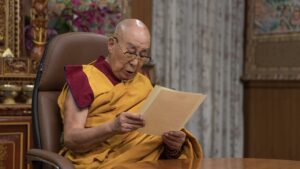The reincarnation of the Dalai Lama restrains the growth of the Han in Tibet.
Even though tomorrow marks the 14th Dalai Lama’s 90th year on Earth, his choice to reincarnate represents a significant setback to Beijing’s military conquest of the world’s highest plateau and the rapidly growing Han influence over Tibet.
Tenzin Gyatso’s decision to reincarnate has offered hope to the six million Tibetan Buddhists who have been subjected to Chinese rule for the past 75 years and revitalized the ancient institution of the Dalai Lama. By continuing the tradition of the temporal and religious head of Tibet in exile and refusing to bend down to Han China’s cultural imperialism, he has also boosted Tibetan Buddhism internationally.

The Dalai Lama is the focus of all four schools of Tibetan Buddhism—Nyingma, Sakya, Kagyu, and Gelug—and he chooses his own reincarnation in spite of the Communist Party of China’s attempts to influence the situation in Tibet for greater political advantage.
The 14th Lama’s death was supposed to be a natural death for the Dalai Lama institution, but China and its followers in India were shocked to learn that Avalokiteshvara, the Buddha of Compassion, had reincarnated. The 15th Dalai Lama will be born in the free world rather than under the totalitarian rule of China, as the Gaden Pradhong Trust, led by his guru Samdhong Rinpoche, will decide the reincarnation. Additionally, it implies that the reincarnation will not be connected to the conflict surrounding the Karmapa, the leader of the powerful Kagyu school, or the Panchem Lama. The decision by Chinese President Xi Jinping to meet with Gyaltsen Norbu, the Chinese Panchem Lama, on June 6, 2025, demonstrates
The 15th Dalai Lama, who was anointed by the Gaden Pradhong Trust, will undoubtedly not be recognized by Beijing, but it is equally easy to anticipate that China would install its own Dalai Lama via the puppet Norbu and the planned “Golden Urn” method. Since the six-year-old Panchem Lama went disappeared in China in 1995, nothing is known about the 14th Dalai Lama’s anointed leader.
The fact is that China’s occupation of the high plateau will never be finished as long as the Dalai Lama institution remains viable and recognized in Buddhist Tibet.
Background
The institution of the Dalai Lama began formally in 1578, following an alliance between the 3rd Dalai Lama, Sonam Gyatso, and Mongol ruler Altan Khan. The Dalai Lama is believed to be the reincarnation of Avalokitesvara, the Bodhisattva of Compassion, and is both a spiritual and cultural leader.
Reincarnations are typically recognized by visions, indications, and tests, including identifying items that belonged to the previous Dalai Lama.
When the Qing government implemented the “Golden Urn” system in 1792, it was a political ploy masquerading as religious equity. Tibetans have frequently rejected it in practice. The so-called Urn system was not used to designate the 14th Dalai Lama.
Actions taken to ensure the 14th Dalai Lama’s succession outside of China
In order to ensure religious freedom, His Holiness asks that his successor be born outside of Chinese-controlled territory, most likely in India.
Potential for a Living-Appointed or Female Successor
The Dalai Lama has stated that a female successor is welcome. In order to avoid such meddling, he has also suggested appointing his successor while he is still alive (a process known as “emanation”).
Trust in Gaden Phodrang as a Spiritual Guardian
The Dharamsala-based official trust in exile will oversee the search, providing a methodical counterpoint to Chinese assertions.









